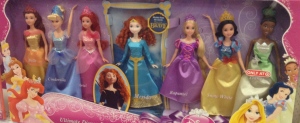Like the majority of American children, I grew up watching, and loving, Disney. The Little Mermaid, The Lion King, Tarzan, and Pocahontas were just a few of my favorites.
Little did I know, that aside from getting me to stop bothering my parents for an hour or so, these movies had larger implications on my sense of self. Unknowingly, these films taught me a great deal about my roles and responsibilities as a woman in US culture. How to look, how to act and how to dress are just a few of the lessons I learned from Disney.

This even went as far as owning (and loving) my very own Cinderella dress. Girls are taught to value their looks over their innate self worth, and to aspire to be princess over everything else from day one.Thanks, Disney. While there is nothing wrong with bring a Princess, it is important that girls are taught that they can be more than a Princess.
A great deal of Disney films portray strict gender roles, norms, and appearances.
Disney teaches children that women have:
- Thin, long hair
- Flawless skin
- Tiny waists
- Long eyelashes
- Perfect lips
Women are beautiful, yet weak, and they need a strong handsome man to save them. Also, in Disney, females are either princesses, or they are ugly and evil.
Disney teaches children that men are:
- Strong
- Tall
- Courageous
- Handsome
- Warriors
There is little room for weak men in Disney.
These ideas follow us into our teenage hood and beyond. These ideas influence our preferences as children, the toys we play with, and ultimately, our personalities and behaviors.
A line from Mulan that nails this point occurs when describing the perfect girl to fight for…”I couldn’t care less what she’ll wear or what she looks like…it all depends on what she cooks like.”
Gender roles, anyone?
Recently, a Frozen craze took over the US, with claims that the film is more progressive than Disney films of the past. While there are positive moments in the film, such as Elsa’s self empowering bout Let It Go, and Elsa’s refusal to let Anna marry a man she just met, the film still plays upon traditional feminine beauty standards such as thin and white, with big eyes.
It seems as though Disney has a lot more work to do.
Check out this video for an nice summary of Disney’s portrayal of gender roles:
What do you think? Thanks for reading!

Hello! Thank you so much for your reply. It looks like your reply got cut off somehow – but I would love to hear more about your experiences at Disneyland!
LikeLike
You hit the nail on the head– the media/entertainment we consume has such a huge effect of children’s perception of gender and their self-worth later down the line. I’m happy to see that more children’s entertainment is featuring people of color, diverse body size, and background, but we certainly have a long way to go!
LikeLike
msdionnedavenport, you’re 100% right! Media influences us more than we often realize. There’s an awesome organization called Common Sense Media that publishes reviews and ratings on different sources of media so parents can make the best choices for their children . Check it out here: http://www.commonsensemedia.org
You’re right that entertainers are starting to provide more wholesome representations of diversity in their media, but as always, there is more work to be done!
LikeLike